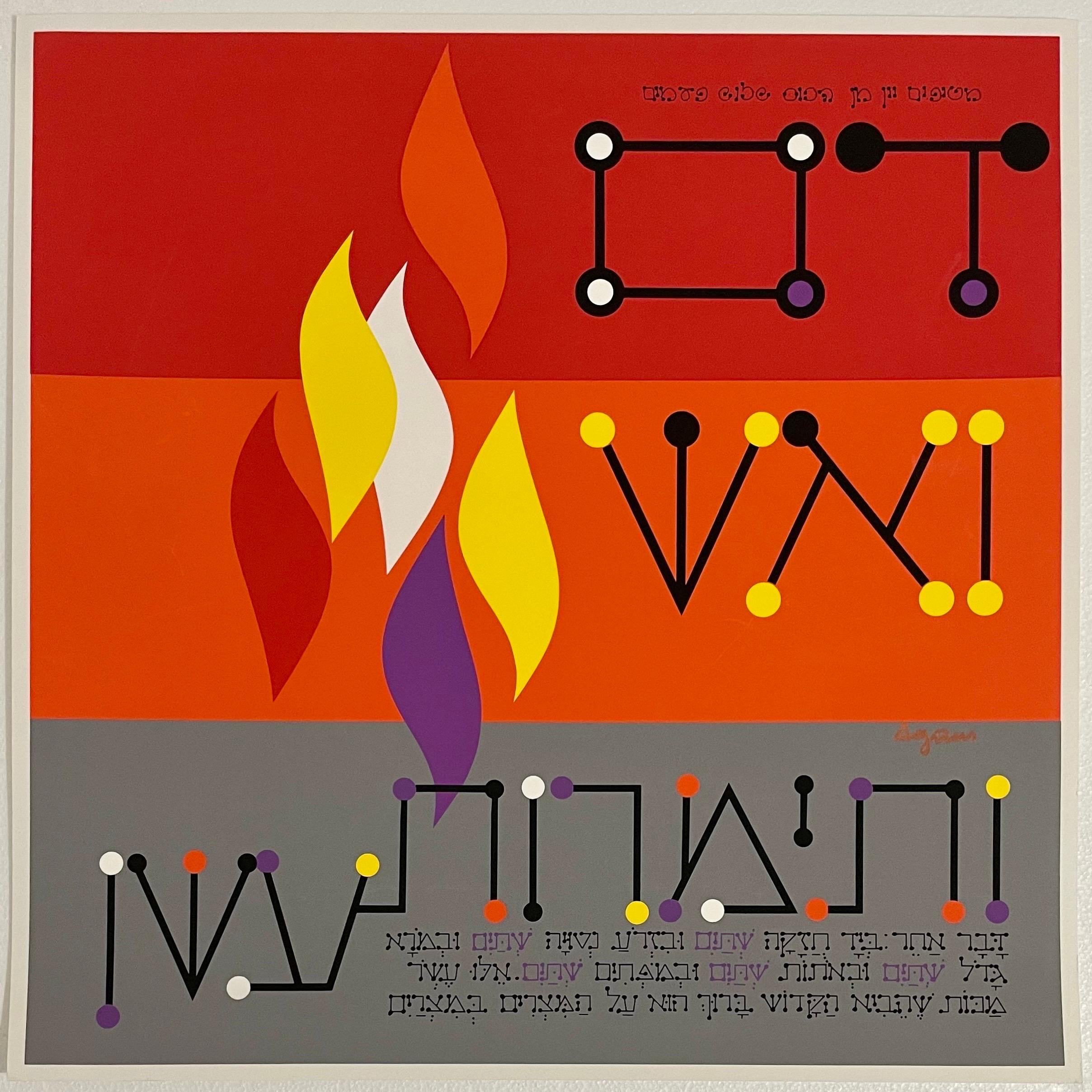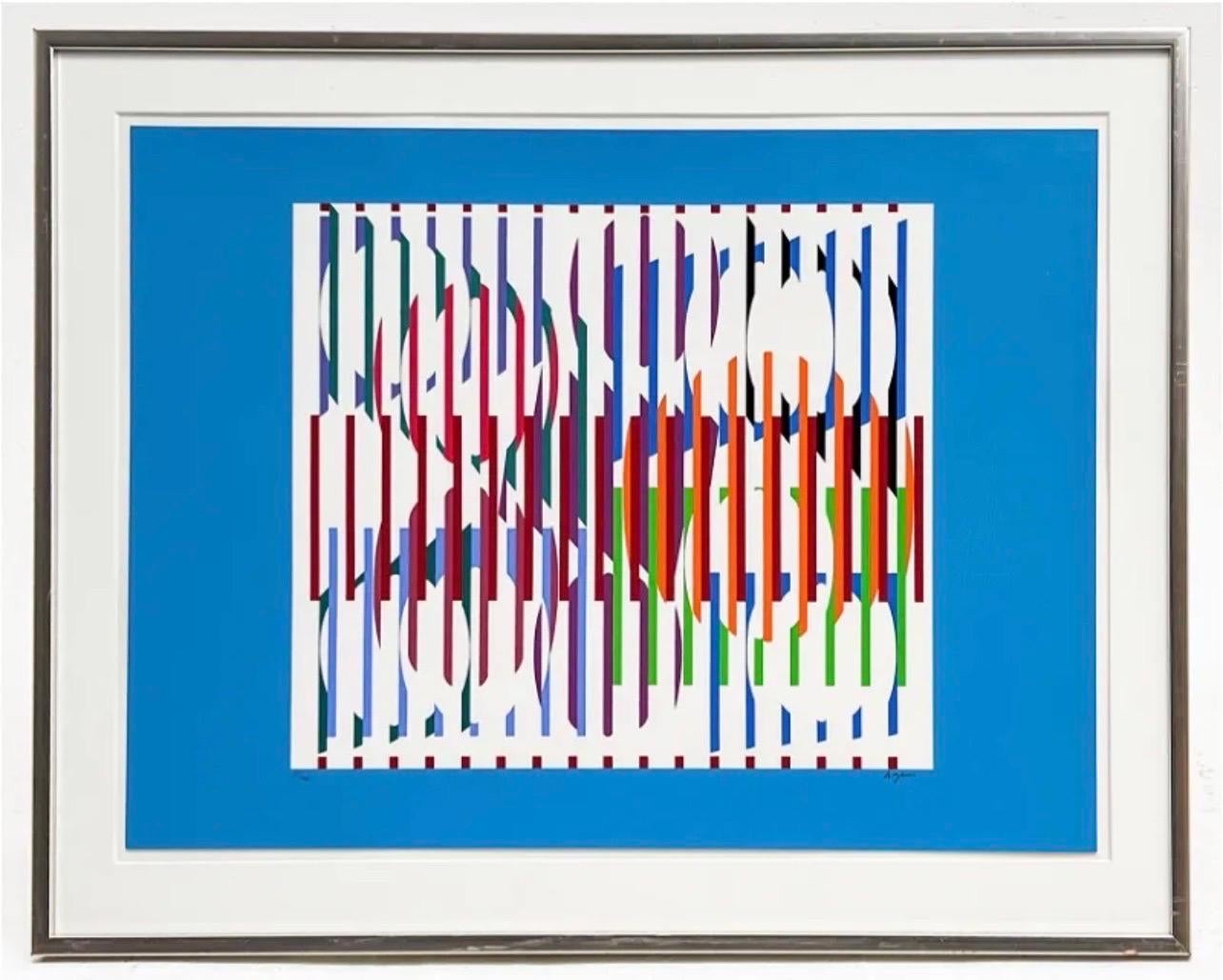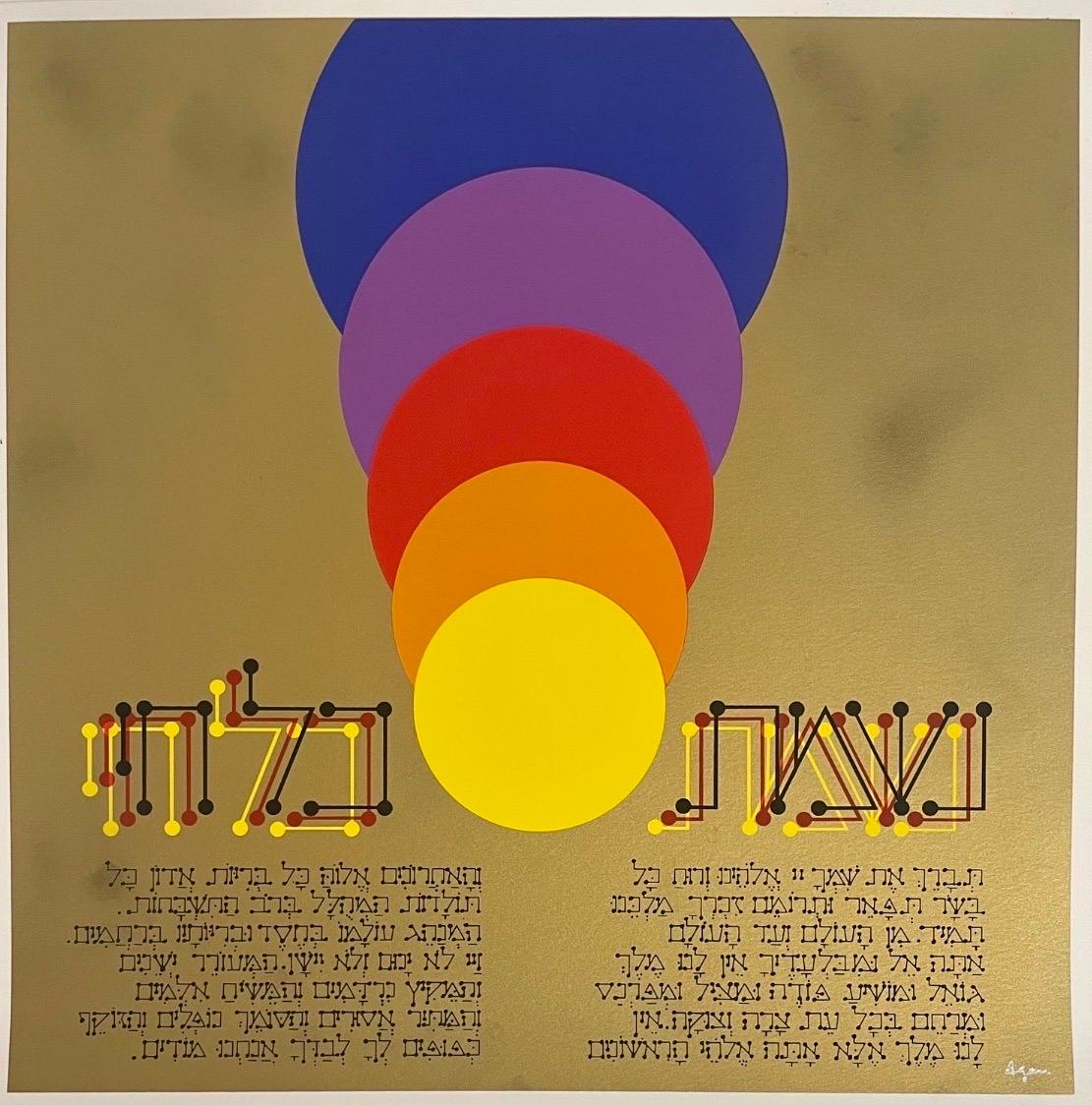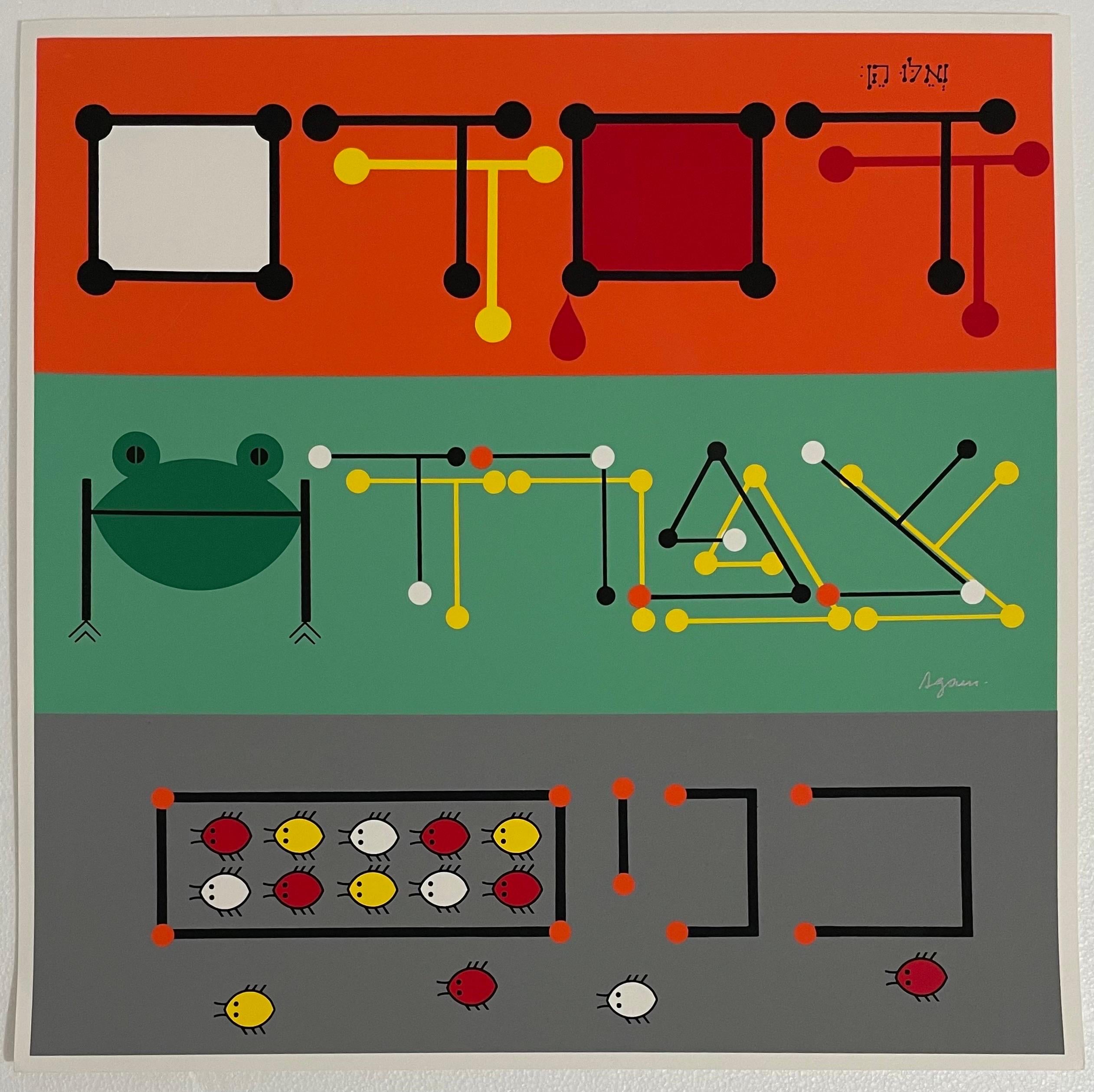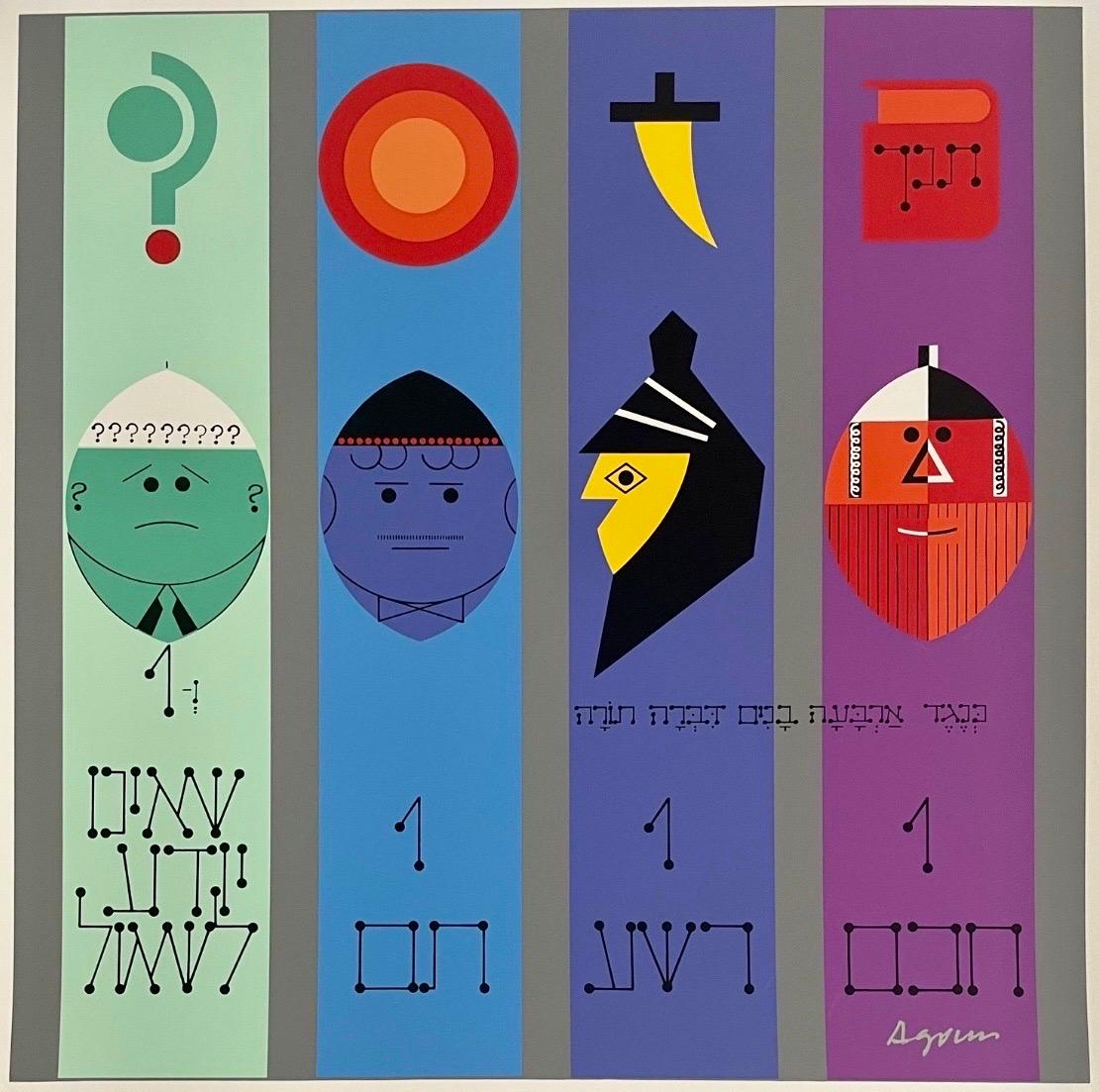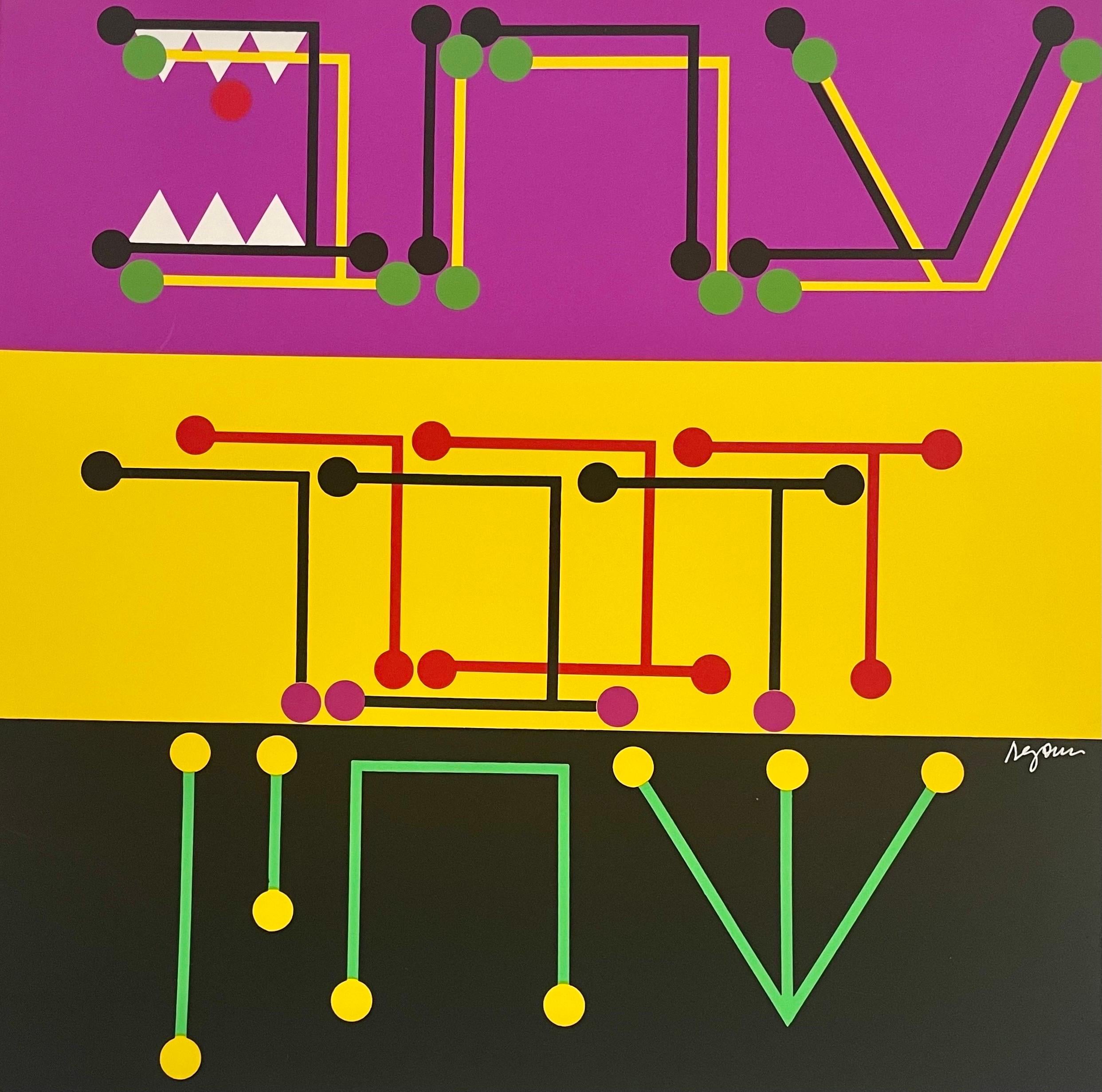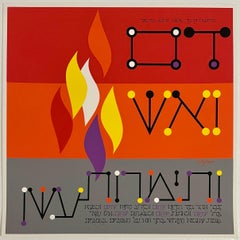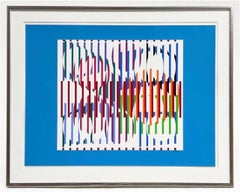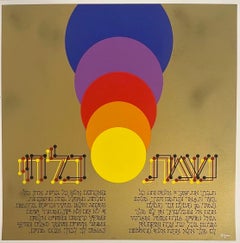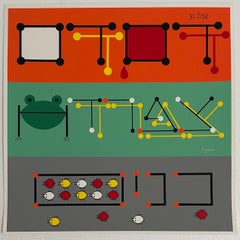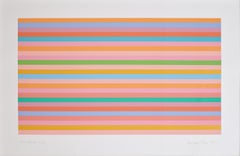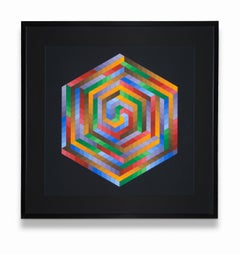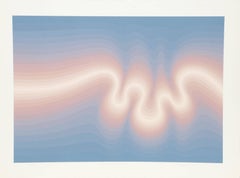Items Similar to Puerto Rican Abstract Geometric Op Art Silkscreen Lithograph Kinetic Art
Want more images or videos?
Request additional images or videos from the seller
1 of 9
Tony BecharaPuerto Rican Abstract Geometric Op Art Silkscreen Lithograph Kinetic Artc.1979
c.1979
About the Item
Color Grid. Ziggurat form. Hand signed and numbered silkscreen.
Tony Bechara, Artist born in Puerto Rico in 1942. Painter, printmaker. Bechara attended Georgetown University in Washington, D.C., and the School of Jurisprudence and Diplomacy at that same university. He spent one year at the Sorbonne in Paris and, finally, entered New York University. Later, he attended the School of Visual Arts in New York City. Since 1977 he has taken part in numerous group and solo exhibits in Puerto Rico, the United States, Europe, and Latin America. An acrylic painter known for pointillism, meaning many vibrant, mulit-colored small dots and grids, Tony Bechara is also an appointee of Mayor Michael Bloomberg of New York City to the City's Latin Media and Entertainment Commission, whose purpose is to promote Latin American media culture. Bechara is also Chairman of the Board of El Museo del Barrio, New York's only Latino museum dedicated to Puerto Rican, Caribbean and Latin American art.
In 2006 he was awarded first prize by the California Museum of Latin American Art. His conceptual interest, in his own words, centers on the dynamics of color and the expressive possibilities of Pointillism and abstract geometry. His work is related to “automatic painting” and the uncontrolled gestures of Dada artists such as Hans Jean Arp and Surrealist such as Andre Masson. This also bears similarities albeit more formally geometric to mexican Modernist Pedro Friedeberg.
Each painting is constructed in a predetermined number of colors, distributed systematically but applied at random as countless dots and daubs. The general pattern that results is, then, unpredictable.
ONE PERSON EXHIBITIONS
1980 Apollon Galerie Die Insel, Munich, Germany
1980 Cayman Gallery, New York City (Graphics)
1980 Bild & Rahmen Gallery, Munich Germany (Graphics)
1982 Gallery Yves Arman, New York City
1984 Georgetown Artists Space, Washington, D.C.
1985 Museo del Barrio, New York City
1986 Hubert Humphrey Building, Main Gallery, Department of Education, Washington, D.C.
1989 Alternative Museum, New York City
1993 Artist Space, New York City
2006 Latincollector, NYC
2006 Andre Zarre Gallery, New York City
2006 Ramis Barquet Gallery, Monterrey, Mexico
SELECTED GROUP EXHIBITIONS
1977 "Biennial", Whitney Museum of American Art, New York City
1976 "Magnet; New York", Center for Inter-American Relations, New York City
1978 "Resurgence '78", El Barrio Museum, New York City
1978 "Bridges", Henry Street Settlement House, New York City
1979 "Five New Painters", Soho Center for Visual Arts, New York City
1979 "Criss-Cross Patterns", Fine Arts Center, Boulder Colorado
1979 "Fifteen New Talents", Aldrich Museum of Contemporary Art, Connecticut
1979 "Latin American Painters", Queens Museum, New York City
1980 "Islamic Allusions", Alternative Museum, New York City, A.Kingsley, Curator
AWARDS
National Endowment for the Arts, Fellowship, 1980
MOLAA Art Prize, Museum of Latin American Art, 2006
Latinos of the Year, El Diario La Prensa, November 1, 2006
COLLECTIONS
Aldrich Museum of Contemporary Art, Ridgefield, Connecticut
Albright Museum, Reading, Pennsylvania
El Barrio Museum, New York City
Harlem Art Collection, New York State Office Building, New York City
Massachusetts Institute of Technology, Cambridge, Massachusetts
Mobil Corporation
Owens Corning Fiberglass Corporation, Toledo, Ohio
Chermayeff & Geismar Associates, Inc., New York City
The Brodsky Organization, NYC
Museo de Arte de Puerto Rico
PUBLIC COMMISSIONS
Art Across the Park, Central Park, N.Y.C. Dept. of Cultural Affairs, 1982
Mural, Cooper Square Development Corporation, New York City 1988
- Creator:Tony Bechara (1942, Puerto Rican)
- Creation Year:c.1979
- Dimensions:Height: 29.75 in (75.57 cm)Width: 22.25 in (56.52 cm)
- Medium:
- Movement & Style:
- Period:
- Condition:good. minor wear. please see photos.
- Gallery Location:Surfside, FL
- Reference Number:1stDibs: LU38214438092
About the Seller
4.9
Platinum Seller
Premium sellers with a 4.7+ rating and 24-hour response times
Established in 1995
1stDibs seller since 2014
1,744 sales on 1stDibs
Typical response time: 2 hours
- ShippingRetrieving quote...Shipping from: Surfside, FL
- Return Policy
Authenticity Guarantee
In the unlikely event there’s an issue with an item’s authenticity, contact us within 1 year for a full refund. DetailsMoney-Back Guarantee
If your item is not as described, is damaged in transit, or does not arrive, contact us within 7 days for a full refund. Details24-Hour Cancellation
You have a 24-hour grace period in which to reconsider your purchase, with no questions asked.Vetted Professional Sellers
Our world-class sellers must adhere to strict standards for service and quality, maintaining the integrity of our listings.Price-Match Guarantee
If you find that a seller listed the same item for a lower price elsewhere, we’ll match it.Trusted Global Delivery
Our best-in-class carrier network provides specialized shipping options worldwide, including custom delivery.More From This Seller
View AllAgam Silkscreen Mod Judaica Lithograph Hand Signed Israeli Kinetic Op Art Print
By Yaacov Agam
Located in Surfside, FL
Yaacov Agam
Israeli (b. 1928)
Hand signed, not individually numbered but from edition of 180. I can include a copy of the title sheet with the edition size and his signature if you request.
sheet: 13.5 X 13.5 inches
Some of these works have beautiful Hebrew calligraphy and mod imagery, animals, children and such that are not usually found in his work. This is a masterpiece of bold, graphic, mod design. Along with Reuven Rubin and Menashe Kadishman he is among Israel's best known artists internationally.
Biographical info: The son of a rabbi, Yaacov Agam can trace his ancestry back six generations to the founder of the Chabad movement in Judaism. in 1946, he entered the Bezalel Academy of Arts and Design in Jerusalem. Studying with Mordecai Ardon, a former student at the Weimar Bauhaus. Yaakov Agam has been associated h with “abstract” artists, “hard edge” artists, and artists such as Josef Albers and Max Bill. Others find in Agam’s work an indebtedness to the masters of the Bauhaus. Agam’s approach to art, being conceptual in nature, has been likened to Marcel Duchamp’s, who expressed the need to put art “at the service of the spirit.” And, because of Agam’s employment of color and motion in his art, he has been compared to Alexander Calder, the artist who put sculpture into motion. (Motion is not an end, but a means for Agam. Calder’s mobiles are structures that are fixed, revolving at the whim of the wind. In a work by Agam, the viewer must intervene.) Agam has also been classified as an “op art” artist because he excels in playing with our visual sensitivities. Agam went to Zurich to study with Johannes Itten at the Kunstgewerbeschule. There, he met Frank Lloyd Wright and Siegfried Giedion, whose ideas on the element of time in art and architecture impressed him. In 1955, Galerie Denise René hosted a major group exhibition in connection with Vasarely's painting experiments with movement. in addition to art by Vasarely, it included works by Yaacov Agam, Pol Bury, Soto and Jean Tinguely, among others. Most Americans were first introduced to Vasarely by the groundbreaking exhibition, "The Responsive Eye," at New York's Museum of Modern Art in 1965. Josef Albers, Richard Anuszkiewicz. The show confirmed Vasarely's international reputation as the father of Op art. Agam has sought to express his ideas in a non-static form of art. In his abstract Kinetic works, which range from paintings and graphics to sculptural installations and building facades. Agam continually seeks to explore new possibilities in form and color and to involve the viewer in all aspects of the artistic process. Thus, for the past 40 years, Yaacov Agam’s pioneering ideas have impacted developments in art, (painting, monoprint, lithograph and agamograph) architecture, theatre, and public sculpture. Reflecting both his Israeli Jewish...
Category
1980s Op Art Abstract Prints
Materials
Lithograph, Screen
Agam Silkscreen Mod Judaica Lithograph Hand Signed Israeli Kinetic Op Art Print
By Yaacov Agam
Located in Surfside, FL
Yaacov Agam
Israeli (b. 1928)
Hommage aux Prix Nobel (1974) Serigraph
signed lower right, numbered 85/100
sheet: 22 x 29 3/4 inches
frame dimensions: 28 x 35 1/2 x 1 inches, wood fra...
Category
1990s Op Art Abstract Prints
Materials
Screen, Lithograph
Agam Silkscreen Mod Judaica Lithograph Hand Signed Israeli Kinetic Op Art Print
By Yaacov Agam
Located in Surfside, FL
Yaacov Agam
Israeli (b. 1928)
Hand signed, not individually numbered but from edition of 180. I can include a copy of the title sheet with the edition size and his signature if you r...
Category
1980s Op Art Abstract Prints
Materials
Lithograph, Screen
Agam Silkscreen Mod Judaica Lithograph Hand Signed Israeli Kinetic Op Art Print
By Yaacov Agam
Located in Surfside, FL
Yaacov Agam
Israeli (b. 1928)
Hand signed, not individually numbered but from edition of 180. I can include a copy of the title sheet with the edition size and his signature if you request.
sheet: 13.5 X 13.5 inches
Some of these works have beautiful Hebrew calligraphy and mod imagery, animals, children and such that are not usually found in his work. This is a masterpiece of bold, graphic, mod design. Along with Reuven Rubin and Menashe Kadishman he is among Israel's best known artists internationally.
Biographical info: The son of a rabbi, Yaacov Agam can trace his ancestry back six generations to the founder of the Chabad movement in Judaism. in 1946, he entered the Bezalel Academy of Arts and Design in Jerusalem. Studying with Mordecai Ardon, a former student at the Weimar Bauhaus. Yaakov Agam has been associated h with “abstract” artists, “hard edge” artists, and artists such as Josef Albers and Max Bill. Others find in Agam’s work an indebtedness to the masters of the Bauhaus. Agam’s approach to art, being conceptual in nature, has been likened to Marcel Duchamp’s, who expressed the need to put art “at the service of the spirit.” And, because of Agam’s employment of color and motion in his art, he has been compared to Alexander Calder, the artist who put sculpture into motion. (Motion is not an end, but a means for Agam. Calder’s mobiles are structures that are fixed, revolving at the whim of the wind. In a work by Agam, the viewer must intervene.) Agam has also been classified as an “op art” artist because he excels in playing with our visual sensitivities. Agam went to Zurich to study with Johannes Itten at the Kunstgewerbeschule. There, he met Frank Lloyd Wright and Siegfried Giedion, whose ideas on the element of time in art and architecture impressed him. In 1955, Galerie Denise René hosted a major group exhibition in connection with Vasarely's painting experiments with movement. in addition to art by Vasarely, it included works by Yaacov Agam, Pol Bury, Soto and Jean Tinguely, among others. Most Americans were first introduced to Vasarely by the groundbreaking exhibition, "The Responsive Eye," at New York's Museum of Modern Art in 1965. Josef Albers, Richard Anuszkiewicz. The show confirmed Vasarely's international reputation as the father of Op art. Agam has sought to express his ideas in a non-static form of art. In his abstract Kinetic works, which range from paintings and graphics to sculptural installations and building facades. Agam continually seeks to explore new possibilities in form and color and to involve the viewer in all aspects of the artistic process. Thus, for the past 40 years, Yaacov Agam’s pioneering ideas have impacted developments in art, (painting, monoprint, lithograph and agamograph) architecture, theatre, and public sculpture. Reflecting both his Israeli Jewish...
Category
1980s Op Art Abstract Prints
Materials
Lithograph, Screen
Agam Silkscreen Mod Judaica Lithograph Hand Signed Israeli Kinetic Op Art Print
By Yaacov Agam
Located in Surfside, FL
Yaacov Agam
Israeli (b. 1928)
Hand signed, not individually numbered but from edition of 180. I can include a copy of the title sheet with the edition size and his signature if you request.
sheet: 13.5 X 13.5 inches
Some of these works have beautiful Hebrew calligraphy and mod imagery, animals and such that are not usually found in his work. This is a masterpiece of bold, graphic, mod design. Along with Reuven Rubin and Menashe Kadishman he is among Israel's best known artists internationally.
Biographical info: The son of a rabbi, Yaacov Agam can trace his ancestry back six generations to the founder of the Chabad movement in Judaism. in 1946, he entered the Bezalel Academy of Arts and Design in Jerusalem. Studying with Mordecai Ardon, a former student at the Weimar Bauhaus. Yaakov Agam has been associated h with “abstract” artists, “hard edge” artists, and artists such as Josef Albers and Max Bill. Others find in Agam’s work an indebtedness to the masters of the Bauhaus. Agam’s approach to art, being conceptual in nature, has been likened to Marcel Duchamp’s, who expressed the need to put art “at the service of the spirit.” And, because of Agam’s employment of color and motion in his art, he has been compared to Alexander Calder, the artist who put sculpture into motion. (Motion is not an end, but a means for Agam. Calder’s mobiles are structures that are fixed, revolving at the whim of the wind. In a work by Agam, the viewer must intervene.) Agam has also been classified as an “op art” artist because he excels in playing with our visual sensitivities. Agam went to Zurich to study with Johannes Itten at the Kunstgewerbeschule. There, he met Frank Lloyd Wright and Siegfried Giedion, whose ideas on the element of time in art and architecture impressed him. In 1955, Galerie Denise René hosted a major group exhibition in connection with Vasarely's painting experiments with movement. in addition to art by Vasarely, it included works by Yaacov Agam, Pol Bury, Soto and Jean Tinguely, among others. Most Americans were first introduced to Vasarely by the groundbreaking exhibition, "The Responsive Eye," at New York's Museum of Modern Art in 1965. Josef Albers, Richard Anuszkiewicz. The show confirmed Vasarely's international reputation as the father of Op art. Agam has sought to express his ideas in a non-static form of art. In his abstract Kinetic works, which range from paintings and graphics to sculptural installations and building facades. Agam continually seeks to explore new possibilities in form and color and to involve the viewer in all aspects of the artistic process. Thus, for the past 40 years, Yaacov Agam’s pioneering ideas have impacted developments in art, (painting, monoprint, lithograph and agamograph) architecture, theatre, and public sculpture. Reflecting both his Israeli Jewish...
Category
1980s Op Art Abstract Prints
Materials
Lithograph, Screen
Agam Silkscreen Mod Judaica Lithograph Hand Signed Israeli Kinetic Op Art Print
By Yaacov Agam
Located in Surfside, FL
Yaacov Agam
Israeli (b. 1928)
Hand signed, not individually numbered but from edition of 180. I can include a copy of the title sheet with the edition size and his signature if you r...
Category
1980s Op Art Abstract Prints
Materials
Lithograph, Screen
You May Also Like
Rose Horizontal -- Screen Print, Stripes, Patterns, Op Art by Bridget Riley
By Bridget Riley
Located in London, GB
BRIDGET RILEY
Rose Horizontal, 2018
Screenprint in colours, on Fabriano 5 paper
Signed, titled, dated and numbered from the edition of 75
Printed by A...
Category
2010s Op Art Abstract Prints
Materials
Screen
Victor Vasarely Screen Print Abstract, Geometric Squares Cubes Hexagon
By Victor Vasarely
Located in Detroit, MI
Victor Vasarely born in 1906 was a Hungarian-French artist, who is widely accepted as a "grandfather" and leader of the Op Art movement. Op Art is a form of abstract art that gives the illusion of movement by the precise use of pattern and color, or in which conflicting patterns emerge and overlap. Victor Vasarely and Brigit Riley are its most famous exponents. In its visual balancing act of color and movement from a flat plane to developed continuous flow “Untitled” is a complex arrangement of squares and colors that visually expand and contract. It is one of Vasarely’s most successful Op Art abstract works. The piece is signed on the lower right and number 20/150 on the lower left. The print is behind glass and matted.
Vasarely was born in Pecs and grew up in Slovakia and Budapest, where in 1925, he took up medical studies. Abandoning medicine he turned to traditional academic painting at the private Podolini-Volkmann Academy. In 1928/1929, he enrolled at Sandor Bortnyik’s private art school widely recognized as Budapest's centre of Bauhaus studies. His studies concentrated on applied graphic art and typographical design. In 1929, he painted his Blue Study and Green Study. In 1930, he married his fellow student Claire Spinner (1908–1990). Together they had two sons, Andre and Jean-Pierre. Vasarely became a graphic designer and a poster artist during the 1930s combining patterns and organic images with each other.
Vasarely utilized geometric shapes and colorful graphics, the artist created compelling illusions of spatial depth, as seen in his work Vega-Nor (1969). Vasarely’s method of painting borrowed from a range of influences, including Bauhaus design principles, Wassily Kandinsky, and Constructivism. In the late 1920s, Vasarely enrolled at the Muhely Academy in Budapest, where the syllabus was largely based on Walter Gropius’s Bauhaus school in Germany.
After settling in Paris in 1930, Vasarely worked in advertising agencies to support himself as a graphic artist while creating many works including Zebra (1937), which is considered by some to be one of the earliest examples of Op Art. The artist experimented in a style based in Surrealism and Abstract Expressionism during the 1940s, before arriving at his hallmark checkerboard...
Category
Mid-20th Century Op Art Abstract Prints
Materials
Paper, Screen
Polarization, OP Art Screenprint by Roy Ahlgren
By Roy Ahlgren
Located in Long Island City, NY
Artist: Roy Ahlgren, American (1927 - 2011)
Title: Polarization
Year: 1981
Medium: Screenprint, signed and numbered in pencil
Edition: 150
Image Size: 18 x 25 inches
Size: 22 x 29.5 ...
Category
1980s Op Art Abstract Prints
Materials
Screen
$480 Sale Price
20% Off
Harlequin, OP Art Silkscreen by Victor Vasarely
By Victor Vasarely
Located in Long Island City, NY
Harlequin by Victor Vasarely, Hungarian (1908–1997)
Date: circa 1980
Screenprint, signed and numbered in pencil
Edition of 78/250
Image Size: 25.75 x 16 inches
Size: 30.5 x 19.75 in....
Category
1980s Op Art Abstract Prints
Materials
Screen
K-PBMB, Geometric Op Art Screenprint by Josef Levi
By Josef Levi
Located in Long Island City, NY
This screenprint was created by American artist Josef Levi. Levi is especially known for his interest in the visual similarities that transcend cultures, like the pattern shown here....
Category
1970s Op Art Abstract Prints
Materials
Screen
Carlos Cruz-Diez ( 1923 – 2019 ) – hand-signed Serigraphy on Arches paper – 1994
By Carlos Cruz-Diez
Located in Varese, IT
color serigraphy on Arches paper, edited in 1994
Limited Edition of 130 copies
signed and dated in pencil by artist in lower right and numbered 83/130 lower left
Paper size: 100 x 70...
Category
1990s Op Art Abstract Prints
Materials
Paper, Screen
Recently Viewed
View AllMore Ways To Browse
Retro Islamic Art
Vintage Entertainment Center
Pedro Friedeberg Hand
Pend Oreille
Pequignet Watch
Per Anderson
Peter Ting
Pharrell Williams Vintage
Photo Cader
Phyllis Diebenkorn
Picasso 156 Series Etchings
Picasso Ecuyere
Picasso Etchings Cirque
Picasso La Pique 1959
Picasso Le Viol
Picasso Petite Fleur
Picasso Pichet Espagnol
Picasso Pour Roby
